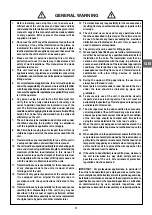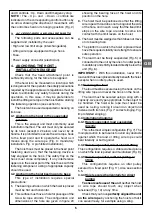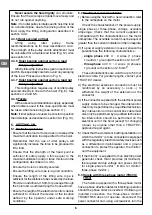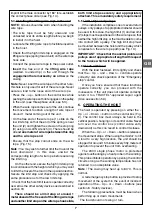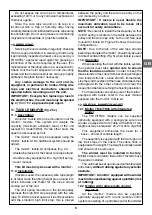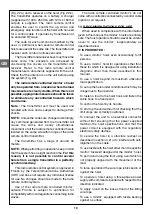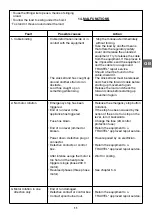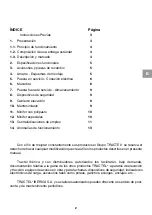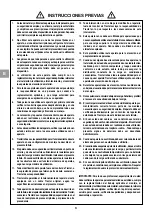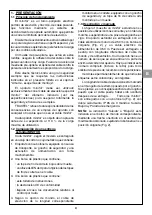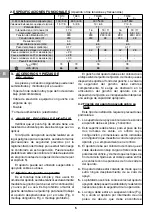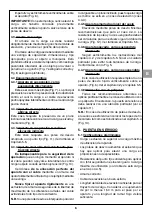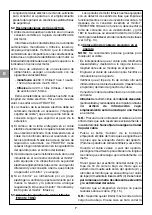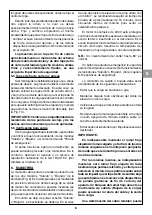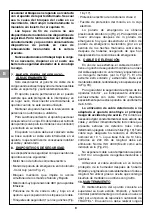
5
and 3 controls : Up, Down and Emergency stop.
NOTE : The « Up » and « Down » controls are
indicated on the corresponding control buttons by
an arrow showing the direction of movement, with
the control box held in its hanging position (Fig. 2)
3. ACCESSORIES AND SPARE PARTS
The following parts and accessories can be
supplied and installed by the user :
• High and low limit stops (interchangeable).
• Lifting wire rope equipped with eye hook.
• Fuse.
• Power supply connector (electrician).
4. ANCHORING THE HOIST –
INSTALLATION DIAGRAM
Check that the fixed attachment point is
sufficiently strong for the force to be applied.
If the hoist is to be mounted in a location which
is dangerous for the operator, the safety precautions
required by the applicable work regulations must be
taken to eliminate any safety hazards during the
operation. In this case, it may be preferable to
install the lifting wire rope in the hoist before starting
the fastening operation (see section 5).
The hoist can be used suspended or bearing on
its base.
4.1 Anchoring the hoist in the suspended
position
This is the easiest and most commonly used
installation method. The unit must only be secured
by its hook (except 4.2 below) and never by its
handle. It is prohibited to secure the wire rope hook
to the fixed point and to operate the hoist as it
moves along the wire rope (Fig. 3: mandatory
installation, Fig. 4: prohibited installation).
The hoist hook must be placed in the fixed point
fastening device so that the fastening device is
fully engaged on the hook. The safety flap on the
hook must close completely. If any interference
appears in the swivel part of the hoist hook with the
fastening component, a sling of appropriate capacity
should be used.
4.2 Anchoring the hoist bearing on its base
This type of installation requires special
precautions :
1. The bearing surface on which the hoist is placed
must be flat and horizontal.
2. This surface must have a hole for passage of the
two wire rope strands. The configuration and
dimensions of the hole are given in figure 24
showing the bearing face of the hoist and its
position on the hole.
3. The hoist must be positioned so that the lifting
wire rope with load does not rub against the side
of the hole, and in such a way that the fixed limit
stops on the wire rope are able to come into
contact with the limit levers on the hoist.
4. The hoist must be wedged so that it does not move
on its bearing face.
5. The platform on which the hoist is placed must
have the required stability and strength to ensure
safe operation.
6. The load must be freely suspended (Fig. 5) or
connected to the unit by means of an idler pulley
mandatorily and strictly located directly below the
unit (Fig. 6).
IMPORTANT : With this installation, never lift a
load until it has been placed directly beneath the hoist,
except when an idler pulley is used.
4.3 Securing the load
The load must be secured using the hook on the
lifting wire rope and never the hook on the hoist.
The load must be secured using a sling with a
capacity, size and type appropriate to the object to
be handled. The hoist wire rope must never be
used as a sling, running it around an object and
fastened with its hook (Fig. 7: correct slinging, Fig.
8: prohibited slinging).
4.4 Installation diagrams
4.4.1 Hoist suspended, load suspended
directly
This is the most simple configuration (Fig. 7). The
main precaution to be taken is to avoid any obstacle
against which the load or lifting wire rope could
bear laterally or butt against.
4.4.2 Hoist suspended, direct slanted lifting
This configuration requires a stable slanted plane
on which the load is pulled and maintained (Fig. 9).
4.4.3 Hoist suspended, indirect pulling or
lifting
This configuration requires an idler pulley
secured to a fixed point (Fig. 11). Also see section
5.5.
4.4.4 Hoist secured horizontally for direct
pulling
To ensure safe use of the unit, neither the hoist
or wire rope should touch any object when
tensioned (Fig. 10) at any time.
Check that you have perfectly aligned the unit
on the wire rope by anchoring the hoist so that it
can swivel freely, for example using a sling.
GB



